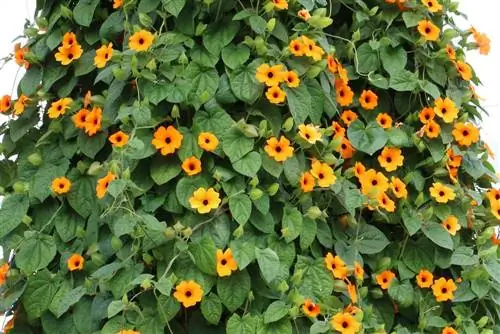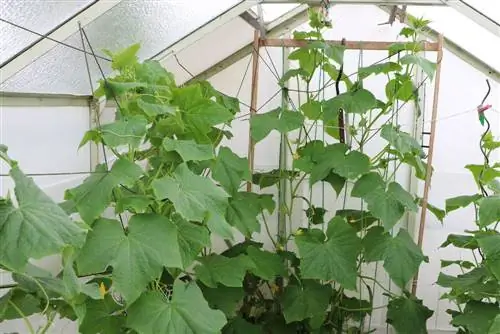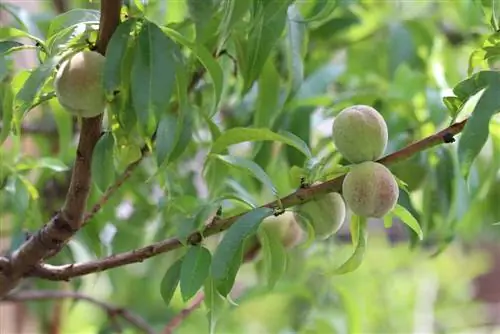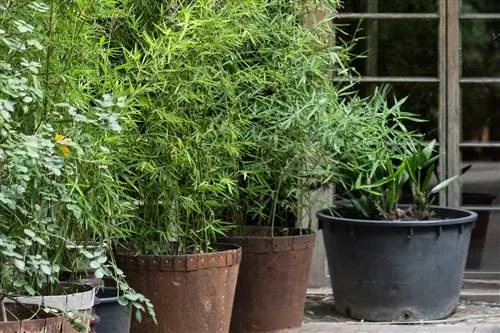- Author admin [email protected].
- Public 2023-12-17 03:39.
- Last modified 2025-06-01 06:48.
In Germany, however, this bamboo is not suitable for outdoor planting; it cannot tolerate subzero temperatures, in contrast to Phyllostachys species, which are also known as flat-cane bamboo. Although they remain somewhat smaller, under optimal conditions they can still reach an impressive height of up to 15 m. They are also very hardy in this country. Depending on the type of bamboo, they can survive temperatures from minus 15 to minus 25 degrees without any problems.
Pulling giant bamboo
Giant bamboo can be grown from seeds. However, sowing is not for the impatient, as it takes a few years for plants grown from seeds to live up to the name giant bamboo.
propagation by sowing
Seeds for cultivation should be purchased from a specialist retailer if possible; this is where the chance of fresh and, above all, germinable seeds is greatest. The older the seeds are, the worse their germination ability is usually. Can be sown all year round. It is beneficial for germination to let the seeds soak in warm water for about 24 hours.
- Fill the growing container with growing substrate
- It is advantageous to use a mini or indoor greenhouse
- Suitable substrates are commercially available growing and pricking soil
- These substrates are particularly permeable to air and low in nutrients
- This also applies to coconut or peat substrate
- Both are mixed with clay granules or perlite in a ratio of 1:1
- Spread the pre-swollen seeds on the substrate
- The seeds of giant bamboo are among the light germinators
- Accordingly, they should not be covered with soil
- Then moisten the substrate
- Now put the whole thing in a bright and warm place without direct sunlight
- For ideal germination conditions, cover with translucent foil
- Temperatures around 25 degrees are optimal for germination
- Even at night it shouldn't be colder than 22 degrees
To prevent the seeds from molding, remove the foil or cover briefly every day or poke small ventilation holes in the foil. Nevertheless, the substrate should be kept evenly moist throughout the entire time, but under no circumstances wet. It takes around 10 to 20 days for germination. Even though giant bamboo of the species Phyllostachys is well hardy, young plants are relatively sensitive to frost. Frost hardiness only increases noticeably with increasing age.
Plants
Giant bamboo in a pot or container can be planted in the garden from spring to summer, preferably from mid-August to the end of September. This gives it enough time to develop a strong root system until winter. In particularly mild regions, it may be possible to plant until autumn. Since this bamboo grows heavily and forms meter-long underground runners that spread extremely, the introduction of a root barrier, also known as a rhizome barrier, is essential.
Containing the runners' urge to spread later by cutting them off is almost impossible, especially with these huge grasses. On the one hand, the roots can hardly be cut with a spade or similar equipment, and on the other hand, even the smallest piece of rhizome would have to be removed from the ground, again and again.
Tip:
If a root barrier is not used despite everything, the probability that this bamboo will spread throughout the entire garden in just a few years and will not stop at property boundaries is very high. In principle, a rhizome barrier can also be added subsequently, but this would be extremely labor-intensive and force-consuming.
Create a root barrier

The garden center offers special rhizome films made of high-pressure polyethylene (HDPE film) in different sizes and thicknesses. Conventional pond liner is completely unsuitable as a root barrier; it is too thin and unstable and would not pose a serious obstacle to the strong roots or runners. To be on the safe side, the film should be 2 mm thick and at best 100 cm wide so that the roots cannot grow under the film. The planting pit must also be dug correspondingly large. Their diameter should be at least 1-2 m larger than that of the future bamboo grove.
- Dig up the soil over a total area of at least 25 m²
- With a 100 cm wide film, the planting hole should be 100 cm deep
- Remove stones and strong root residues in the ground after excavation
- Then place the foil upright in the planting pit
- It should protrude about 5 cm from the ground
- This prevents the roots from growing beyond the foil
- Where it overlaps, screw the foil using an aluminum rail
If the ends of the foil are not closed, the roots can slip through relatively easily at this point, which is actually what the foil is supposed to prevent. Once the root barrier is in place, the pit is filled with soil and the bamboo can be planted. Finally, don’t forget to water thoroughly.
Tip:
To determine the space required by each type of bamboo for the next 15 years, multiply the final height by itself. For a bamboo that is approximately 5 m high, this would result in a total area of 25 square meters, and correspondingly more for higher varieties.
Care instructions
The largest blades of grass in the world grow significantly faster than all other plant species and reach an impressive size in a relatively short time. The location should therefore be well chosen. This way you can also avoid trouble with your neighbors. If the site conditions are optimal, further care is largely limited and is mainly limited to the right amount of watering and fertilizing.
Location
In the right location and with appropriate care, giant bamboo in Germany can reach heights of up to 15 m, which should definitely be taken into account when choosing a location. Otherwise, depending on the variety, giant bamboo prefers sunny or semi-shady locations. In addition, the bamboo should be protected from cold north and east winds as well as winter sun to avoid plant damage. Sufficient distances must be maintained from house walls, as the strong stalks and branches can cause significant damage to the masonry.
Tip:
In order to avoid possible trouble with neighbors, care should be taken to maintain minimum distances from neighboring properties when planting giant bamboo. You can inquire about the relevant regulations from the relevant municipality or authority.
Floor
These giant grasses are also quite undemanding when it comes to soil. It should just be loose, nutrient-rich and slightly moist. Soils that tend to be permanently waterlogged should be avoided, as the giant bamboo would die quite quickly. However, the permeability of heavy soils can be significantly improved by incorporating coarse sand or fine gravel.
Pouring
A part of care that should not be underestimated is watering, because as an evergreen plant, bamboo evaporates a lot of water in both summer and winter due to its high leaf mass. Curled leaves can be an indication of a lack of water. At the same time, this plant also protects itself from heavy evaporation by curling its leaves. There is always a lack of water if the leaves have not rolled up again after sunset, then watering should be carried out as quickly as possible. Basically, the warmer it is, the more water bamboo plants can tolerate. In summer it is advisable to only water early in the morning or in the evening.
Fertilize
In order for the giant bamboo to form its impressive stalks, it needs not only sufficient water but also a well-dosed supply of nutrients. A clear sign of a nutrient deficiency, especially a lack of nitrogen, can be yellowish-colored leaves. Then immediate fertilizer application is recommended. Otherwise, fertilization should be carried out 2 - 3 times a year.
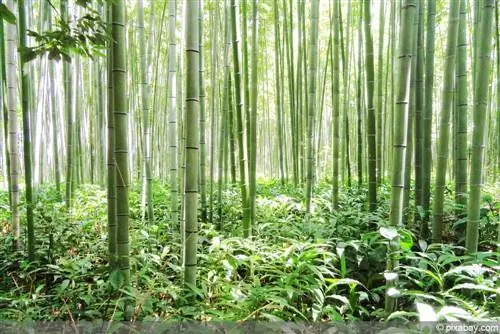
Special bamboo fertilizers with long-term effects are available commercially or you can use organic fertilizers such as horse or cattle manure, compost or coffee grounds. The use of these organic fertilizers provides the grass with all the important nutrients and prevents over-fertilization. Bamboo is a heavy consumer and primarily requires nitrogen, phosphorus, potassium and silica.
Coffee grounds provide exactly these nutrients. However, coffee grounds in particular are usually not available in such large quantities, but are certainly worthwhile as a supplement. Coffee grounds can be mixed very well with horn shavings and then lawn clippings, making a very good fertilizer for these magnificent plants. Manure also contains a lot of nitrogen, but should be well seasoned. It is best to use composted manure from the previous year.
Silicic acid can be added to the grasses by leaving falling bamboo leaves lying around. By rotting this leaf layer, the plant produces the silica it needs itself. If no additional bamboo fertilizer is used, the need for silica in the first few years after planting can also be met with rock powder (Lucian rock powder or bentonite) or horsetail broth.
Cutting
Even if giant bamboo does not necessarily have to be cut, it should not be allowed to grow uncontrollably and prevent wild growth. Too dense vegetation can, under certain circumstances, promote mite infestation or grain rust. To counteract this, dry, thin and old stalks are regularly cut off directly above the ground. Further cutting measures are generally not necessary.
Wintering
While the actual giant bamboo Dendrocalamus giganteus would not survive a winter in the garden in Germany, overwintering outdoors is no problem for giant bamboos of the genus Phyllostachys. However, the winter hardiness of these species also varies between the individual varieties. Some are hardy down to -15 degrees and others up to -25 degrees.
- Winter protection is recommended in the first few years
- This mainly affects young and freshly planted specimens
- To do this, cover the root area with a layer of leaves, straw or brushwood
- Snow on the root area should be left behind
- Its insulating effect is an advantage when wintering
- Wrap the young stalks additionally with a special fleece
- Fleece protects against frost, winter sun and excessive evaporation
- Always shake off wet snow on the stalks
- Especially younger bamboo stalks could break under the weight of snow
You shouldn't let bamboo dry out even in winter. It evaporates a lot of moisture through its leaves, even in the cold season, so it dries out rather than freezes. Therefore, watering should be done on frost-free days. In spring the winter protection must be removed. This prevents the ground from warming up too much and the bamboo sprouting too early. Fertilizer can be completely avoided in winter.
Propagate:
Rhizome pieces
Giant runner-forming bamboo of the genus Phyllostachys can be propagated quickest and easiest via root or rhizome parts. This results in identical offspring of the mother plants. The best time for this is in March or late summer. You shouldn't propagate between April and June because that's when the new stalks grow and don't want to be disturbed. It's best to choose an overcast day. If it has rained and the ground is moist, that's optimal.
To get to the rhizome pieces, you dig up the bamboo in places.exposes individual root parts, which are then freed from soil residues. Individual shoots are then separated and the interfaces are left to air dry for about a day. Then you put them about 5 cm deep in standard potting soil or a loose, sandy substrate and moisten it. Until new growth appears, the soil must be kept evenly moist without being waterlogged.
Tip:
It is better to avoid using peat as a growing medium, it is too acidic.
Division

Division is a little more difficult, especially with older plants. Since it is generally extremely difficult or impossible to dig up the root ball of giant bamboo, parts of the ball including the stalks are cut off with a sharp spade or separated from the plant with an ax. Then you remove about a third of the leaf mass to minimize evaporation and plant the newly obtained plants in the desired location. Don't forget a root barrier when planting the sections.
Pests: Bamboo mite
Basically, giant bamboo is very robust and resilient. Nevertheless, the so-called bamboo mite (Schizotetranychus celarius) has spread, especially in the west and north of Germany. This is not a native pest, but rather an introduced and very cold-tolerant pest. Symptoms of an infestation are whitening of the leaves caused by the mites' sucking activity. If the infestation is advanced, growth disorders can also occur.
To combat it, hobby gardeners can spray repeatedly with wet sulfur. The undersides of the leaves in particular should be treated because this is where the mites live. Specialist retailers also offer systemic miticides (acaricides), which are very effective. However, treatment with this agent should be repeated after 2 - 3 weeks. In the event of an initial infestation, biological control with beneficial insects such as ladybirds and their larvae or special species of predatory mites is also conceivable.
Small care mistakes with a big impact
The supposed illnesses usually turn out to be the result of incorrect care or exceptionally high temperatures below zero in winter. While isolated discolored leaves are completely normal and nothing to worry about, in larger numbers they often indicate deficiency symptoms. Yellow leaves can be the result of too much moisture and brown leaves can indicate drought-related damage. On the other hand, brown-orange leaves are usually an indication of grain rust, which is caused, for example, by planting that is too dense and the associated humidity is too high.
To counteract this, neither too much nor too little should be watered or fertilized. Furthermore, old, thin and dry stalks should always be cut out to prevent the bamboo from becoming too dense. With an occasional shower of the grass, especially the undersides of the leaves, possible pests can be eliminated early before they can spread and cause greater damage.
A style element of impressive size
Giant bamboos are impressive plants with exceptionally fast and stately growth. By the way, bamboo only blooms every 80 to 130 years, after which the Fargesia species in particular die off completely. In Germany, varieties of the genus Phyllostachys are mainly grown. They have the decisive advantage over the actual giant bamboo Dendrocalamus giganteus in that they have good winter hardiness. They have a high decorative value and are fascinating and elegant at the same time. They adapt to different garden stems and when planted correctly, the neighbor also enjoyed these impressive plants.


